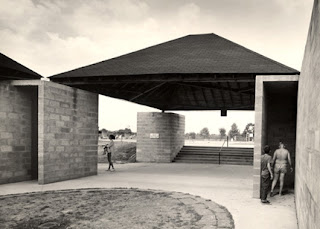As witnessed from the film Playtime by Jacques Tati, modernism had issued the problem of mass-production and an ignorance of traditions and monuments (neo-classicism). A result is a cultural shock, as seen Monsieur Hulot in Playtime, a befuddled Frenchman lost in the new modernity of Paris, which is more repetitive, boring and duller than ever.
However, the expressionists depart from the International Style. As its name implies it is the art of “expressing”, its form and architecture are very expressive, not static but contains movement and momentum, created by deep voids and curvature. It’s a compromise, containing the essence of pure and simplified modernist forms, but also embraces the past (as a ruin). Unlike the International Style it is ‘not’ starting from zero, rather recreates the architecture of the past, the making of new ‘old’ buildings. For example, the recreation of the Pyramids in the Trenton Bath House in 1954. Not only are they expressive but they can also be functional. Like the auditorium of Alvar Aalto’s Vyborg Library with its waved wood ceiling, both expressionistic and functional, constructed from the woods from the forest seen through the windows of the auditorium, in angulation which serves its acoustics. At times, expressionism might even be more functional than the modernist deals of glass boxes, especially in India where Louis Kahn had built the National Assembly Building. The climate in India really allowed for those simplified buildings with no windows, it was clearly functional. Additionally, the cut sphere was able to express the function of the staircase. On the contrary, the glass box Crown Hall of Mies van der Rohe’s wasn’t suited to the cold climate of Chicago, which created an ice laminated granite floor that is too slippery to walk on.
Expressionists have a smart approach to functionality and can simultaneously preserve the simplicity and traditions (not denying the past). While in the process they are able to create a more energetic and dynamic architecture than that of the modernists, which is also aesthetically beautiful.
Trenton Bath House in 1954
Alvar Aalto's Vyborg Library auditorium
Mies van der Rohe's Crown Hall, Chicago
Louis Kahn's National Assembly Building, Dhaka, India




No comments:
Post a Comment